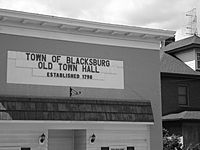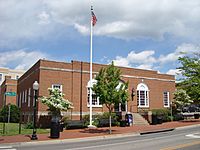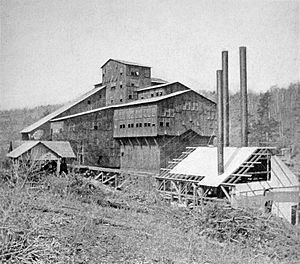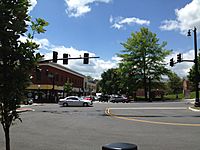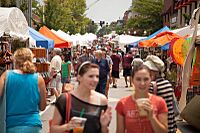Blacksburg, Virginia facts for kids
Quick facts for kids
Blacksburg
|
|
|---|---|
| Town of Blacksburg | |
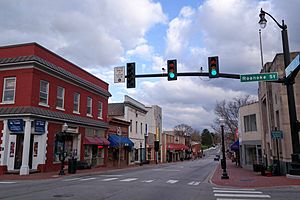
Downtown Blacksburg
|
|
| Country | United States |
| State | Virginia |
| County | Montgomery |
| Founded | 1798 |
| Named for | Samuel Black |
| Area | |
| • Town | 19.77 sq mi (51.20 km2) |
| • Land | 19.74 sq mi (51.12 km2) |
| • Water | 0.03 sq mi (0.08 km2) 0.10% |
| Elevation | 2,080 ft (630 m) |
| Population
(2020)
|
|
| • Town | 44,826 |
| • Density | 2,267.4/sq mi (875.51/km2) |
| • Metro | 181,863 |
| Demonym(s) | Blacksburger |
| Time zone | UTC−5 (EST) |
| • Summer (DST) | UTC−4 (EDT) |
| ZIP Codes |
24060–24063
|
| Area code(s) | 540 |
| FIPS code | 51-07784 |
| GNIS feature ID | 1498405 |
| Website | www.blacksburg.gov |
Blacksburg is a town in Montgomery County, Virginia, United States. In 2020, about 44,826 people lived here. Blacksburg is strongly influenced by Virginia Tech, a large university located in the town.
Blacksburg, along with Christiansburg and Radford, forms a larger area called the Blacksburg-Christiansburg Metropolitan Statistical Area. This area includes several counties and has about 181,863 people. It is one of the fastest-growing areas in Virginia.
Contents
History of Blacksburg
Early Explorers & Native Lands (1671–1771)
In the 1600s, English settlers in Virginia wanted to explore lands beyond the Allegheny Mountains. These mountains were home to Native American tribes. In 1671, explorers Batts and Fallam, sent by Abraham Wood, found a way over the mountains. They followed Stroubles Creek to the area where Blacksburg is today.
They claimed this land for King Charles II. However, different Native American tribes, like the Tutelo and Monacan, lived there. Later, Seneca warriors took control of the area. After some agreements, the land became part of the Virginia colony.
By the 1740s, a large piece of land, including what is now Blacksburg, was given to settlers. The Draper and Ingles families built homes at Draper's Meadow around 1748. This area is now near the Virginia Tech campus.
During the French and Indian War in 1755, Shawnee Indians attacked Draper's Meadow. Several settlers were killed, and some were taken captive. One famous captive was Mary Draper Ingles, who later escaped. A memorial marks this event near Duck Pond.
The Black Family & Town's Beginning (1772–1797)
In 1772, Samuel Black bought land in the Draper's Meadow area for his sons, John and William. Smithfield Plantation was built around 1774 on this land. It is near the Duck Pond on the Virginia Tech campus today.
When Samuel Black died in 1792, his land was split between his sons. John Black's part later became much of the main campus of Virginia Tech. In 1797, William Black designed a small town with 16 blocks on his land. This original town is represented by 16 squares in Blacksburg's town logo.
Blacksburg Becomes a Town (1798–1870)
Blacksburg officially became a town on January 13, 1798. It was named after William Black to honor him.
In 1808, a log cabin was built east of Smithfield Plantation. This cabin, called Solitude, is the oldest building on the Virginia Tech campus. It later became part of the college.
The town's post office opened in 1827 as "BLACKSBURGH." The "h" was removed in 1893, making it "Blacksburg." Early churches were built by Methodists (1830), Presbyterians (1848), and Baptists (1852). The old Presbyterian church building is now a restaurant and is the oldest building on Main Street.
The Blacksburg Female Academy opened in 1840, and the Olin and Preston Institute (a Methodist school) started in 1851. The first bank in Montgomery County opened in Blacksburg in 1849. The first newspaper, the Montgomery Messenger, was printed in 1869.
Growth and Modernization (1871–1951)
In 1871, Blacksburg officially became an incorporated town. Thomas W. Jones became its first mayor.
A year later, the Virginia Agricultural and Mechanical College opened. This college grew and is now known as Virginia Tech. It is Virginia's land-grant university.
Emergency services began to form. A fire-fighting unit started at the university in 1899. The town bought its first fire truck in 1942. The Blacksburg First Aid and Life Saving Crew, now the Blacksburg Volunteer Rescue Squad, was founded in 1951.
Transportation improved greatly. The first car arrived in 1901. A train, nicknamed the "Huckleberry," connected Blacksburg to Christiansburg in 1904. The first gas station opened in 1919. Blacksburg's first landing strip for planes was built in 1929, becoming the Virginia Tech Airport. Local buses started running in 1947.
The town's first theater was built in 1909, which led to the famous Lyric Theatre. By 1935, Main Street had street lights. The first police officer, Dave "Highpockets" Sumner, started in 1937, and the first police car was bought in 1946.
Education & Business Boom (1952–1992)
Blacksburg saw a big increase in schools. The first Blacksburg High School building opened in 1952. Later, it moved to a new location and became Blacksburg Middle School. All high schools in the county began teaching grades K-12 that year.
New elementary schools, Margaret J. Beeks and Gilbert F. Linkous, were built in 1963. Harding Avenue Elementary School opened in 1972. Blacksburg High School moved to Patrick Henry Drive in 1974 due to too many students.
Jack Goodwin became the first chief of police in 1954. Jan Olinger was the first female police officer in 1976.
The "Huckleberry" railroad stopped passenger service in 1958 and freight service in 1966. Years later, the old railroad path was turned into the Huckleberry Trail, which opened in 1998.
Businesses grew in the 1960s. Corning Incorporated opened a factory in 1964. The Blacksburg Municipal Building was built in 1969. Large student apartment complexes, Terrace View and Foxridge, were built. The Blacksburg Branch of the Montgomery County Library opened in 1970. In 1971, LewisGale Hospital Montgomery and the University Mall shopping center opened. The Blacksburg Community Center opened in 1981. The New River Valley Mall opened in Christiansburg in 1988, and the Virginia Tech Corporate Research Center began.
The population of Blacksburg grew from 9,000 to 30,000 in the 1970s. This was partly because Virginia Tech became part of the town. Blacksburg Transit, the local bus system, started in 1983.
The Information Age (1993–Present)
Blacksburg became a leader in computer networking with the Blacksburg Electronic Village (BEV). This project, started by Virginia Tech in 1991 and launched in 1993, connected the town to the Internet. This helped Blacksburg enter the "Information Age."
New schools continued to open, like Kipps Elementary School in 1994. A new Blacksburg library opened in 1996. The Huckleberry Trail was completed in phases, with the first part opening in 1996 and the second in 1998. In 2019, a mountain bike park opened.
The "Smart Road" project began in 1997. This special road is used for research by the Virginia Tech Transportation Institute. A National Weather Service office is also located in Blacksburg.
In 2003, a new building for Blacksburg Middle School opened. In 2010, the old Blacksburg High School gym roof collapsed due to heavy snow. A new Blacksburg High School building opened in 2013.
Geography of Blacksburg
Blacksburg covers about 19.89 square miles (51.20 km2). Most of this is land, with a small amount of water. The town is about 2,080 feet (634 meters) above sea level. It is in the New River Valley and sits on the Eastern Continental Divide. This divide separates rivers that flow to the Atlantic Ocean from those that flow to the Gulf of Mexico.
Blacksburg is the 15th largest municipality and the largest town in Virginia. The tallest building is Slusher Tower, a twelve-story dorm on the Virginia Tech campus.
Blacksburg's Climate
Blacksburg has a hot-summer humid continental climate. This means it has warm to hot summers and cool to cold winters. Because it is high up, it is cooler than lower areas nearby. Summers are humid, but only about 5 days a year reach 90°F (32°C) or higher. Winters have an average of 24.7 inches (63 cm) of snow. The coldest temperature ever recorded was -27°F (-33°C).
| Climate data for Blacksburg, Virginia (1991–2020 normals, extremes 1893–present) | |||||||||||||
|---|---|---|---|---|---|---|---|---|---|---|---|---|---|
| Month | Jan | Feb | Mar | Apr | May | Jun | Jul | Aug | Sep | Oct | Nov | Dec | Year |
| Record high °F (°C) | 75 (24) |
80 (27) |
86 (30) |
95 (35) |
93 (34) |
99 (37) |
100 (38) |
99 (37) |
97 (36) |
94 (34) |
82 (28) |
75 (24) |
100 (38) |
| Mean daily maximum °F (°C) | 41.6 (5.3) |
45.3 (7.4) |
53.2 (11.8) |
63.9 (17.7) |
71.9 (22.2) |
78.9 (26.1) |
82.3 (27.9) |
81.2 (27.3) |
75.8 (24.3) |
65.6 (18.7) |
54.8 (12.7) |
44.9 (7.2) |
63.3 (17.4) |
| Daily mean °F (°C) | 31.9 (−0.1) |
34.7 (1.5) |
41.7 (5.4) |
51.4 (10.8) |
60.2 (15.7) |
67.9 (19.9) |
71.7 (22.1) |
70.4 (21.3) |
64.3 (17.9) |
53.2 (11.8) |
42.7 (5.9) |
35.1 (1.7) |
52.1 (11.2) |
| Mean daily minimum °F (°C) | 22.1 (−5.5) |
24.1 (−4.4) |
30.2 (−1.0) |
38.9 (3.8) |
48.4 (9.1) |
56.9 (13.8) |
61.0 (16.1) |
59.5 (15.3) |
52.9 (11.6) |
40.9 (4.9) |
30.7 (−0.7) |
25.3 (−3.7) |
40.9 (4.9) |
| Record low °F (°C) | −18 (−28) |
−12 (−24) |
−2 (−19) |
10 (−12) |
23 (−5) |
30 (−1) |
34 (1) |
35 (2) |
22 (−6) |
13 (−11) |
−1 (−18) |
−27 (−33) |
−27 (−33) |
| Average precipitation inches (mm) | 3.23 (82) |
2.83 (72) |
3.78 (96) |
3.77 (96) |
4.47 (114) |
4.27 (108) |
4.21 (107) |
3.57 (91) |
3.45 (88) |
2.91 (74) |
2.85 (72) |
3.30 (84) |
42.64 (1,083) |
| Average snowfall inches (cm) | 7.7 (20) |
7.0 (18) |
4.3 (11) |
0.6 (1.5) |
0.0 (0.0) |
0.0 (0.0) |
0.0 (0.0) |
0.0 (0.0) |
0.0 (0.0) |
0.0 (0.0) |
0.4 (1.0) |
4.7 (12) |
24.7 (63) |
| Average precipitation days (≥ 0.01 in) | 11.3 | 10.5 | 12.2 | 12.5 | 13.7 | 12.3 | 12.9 | 11.5 | 9.4 | 9.1 | 9.0 | 11.7 | 136.1 |
| Average snowy days (≥ 0.1 in) | 3.9 | 4.6 | 2.7 | 0.6 | 0.0 | 0.0 | 0.0 | 0.0 | 0.0 | 0.1 | 0.6 | 2.8 | 15.3 |
| Source: NOAA | |||||||||||||
Transportation in Blacksburg
Roads & Highways
Blacksburg is mainly served by US 460. This four-lane highway connects to I-81 at Christiansburg, about 10 miles south. It also connects to I-77 in West Virginia. Driving from Blacksburg to Roanoke usually takes less than an hour.
Buses & Public Transit
Blacksburg Transit (BT) provides bus service, especially to and from the Virginia Tech campus. Students and staff can ride for free because a fee is included in their tuition. Anyone can ride the bus for a small fee.
The Smart Way Bus is a regional bus service. It connects Virginia Tech, downtown Blacksburg, Christiansburg, and Roanoke. From Roanoke, people can connect to an Amtrak train.
Air Travel
The Roanoke–Blacksburg Regional Airport offers commercial flights to several major cities like Atlanta, Charlotte, and Chicago.
The Virginia Tech Montgomery Executive Airport, located in Blacksburg, is used for smaller planes, air taxis, and military flights.
People of Blacksburg (Demographics)
| Historical population | |||
|---|---|---|---|
| Census | Pop. | %± | |
| 1880 | 688 | — | |
| 1900 | 768 | — | |
| 1910 | 875 | 13.9% | |
| 1920 | 1,095 | 25.1% | |
| 1930 | 1,406 | 28.4% | |
| 1940 | 2,133 | 51.7% | |
| 1950 | 3,358 | 57.4% | |
| 1960 | 7,070 | 110.5% | |
| 1970 | 9,384 | 32.7% | |
| 1980 | 30,638 | 226.5% | |
| 1990 | 34,590 | 12.9% | |
| 2000 | 39,573 | 14.4% | |
| 2010 | 42,620 | 7.7% | |
| 2020 | 44,826 | 5.2% | |
| U.S. Decennial Census | |||
In 2020, Blacksburg had 44,826 residents.
According to the 2000 census, there were 39,573 people living in Blacksburg. The town had 13,162 households. About 16.3% of households had children under 18. The average household had 2.37 people.
The population was quite young, with 57.4% of people aged 18 to 24. The median age was 22 years. For every 100 females, there were about 127 males.
The average income for a household was $22,513. About 43.2% of the population lived below the poverty line.
About 87% of Blacksburg residents have Internet access at home. Many people in Blacksburg have a college education, with 70% being graduates of Virginia Tech.
Economy of Blacksburg
Blacksburg is home to the Virginia Tech Corporate Research Center. Many companies, like Honeywell and the National Weather Service, have offices there. MOOG, a big supplier for defense and healthcare, is also in Blacksburg. Rackspace, a company that provides online services, bought a local company here in 2007. The town works to bring more businesses to the area.
Main Employers in Blacksburg
Here are some of the biggest employers in Blacksburg:
| # | Employer | # of Employees |
|---|---|---|
| 1 | Virginia Tech | >5,000 |
| 2 | Moog | >1,000 |
| 3 | HCA Montgomery Regional Hospital | 500 to 999 |
| 4 | NRV Community Services | 250 to 499 |
| 5 | Town of Blacksburg | 250 to 499 |
| 6 | Eaglepicher Wolverine LLC | 250 to 499 |
| 7 | Spectrum (Tetra) | 100 to 249 |
| 8 | Federal-Mogul Corporation | 100 to 249 |
| 9 | Virginia Tech Services, Inc. | 100 to 249 |
| 10 | Luna Innovations | 100 to 249 |
Famous People from Blacksburg
- Frank Beamer, former Head Football Coach at Virginia Tech
- James M. Buchanan, Nobel Prize winner
- Marc Edwards, civil engineering professor
- Nikki Giovanni, famous poet
- Lanto Griffin, PGA Tour Golfer
- Josh Kaufman, winner of The Voice
- Eric Schmidt, former Google CEO
- Brandon Stokley, NFL wide receiver
- Wild Nothing, indie music artist
- James I. Robertson Jr., historian
- James Conrad, professional disc golfer
- Jack Champion, actor
Places to Visit in Blacksburg

- 16 Squares (original town layout)
- Alexander Black House
- Armory Art Gallery
- Blacksburg Farmers Market
- Edward Via College of Osteopathic Medicine
- Hahn Horticulture Garden
- Huckleberry Trail (a walking and biking path)
- Lyric Theatre
- Moss Arts Center
- Municipal (Caboose) Park
- Smithfield Plantation
- Virginia Polytechnic Institute and State University (Virginia Tech)
Annual Town Events
- International Street Fair: Held in spring, this fair celebrates the many countries represented by students at Virginia Tech and people in the community. You can find food, cultural booths, and music from all over the world.
- Steppin' Out: This is Blacksburg's main street festival, held every August since 1981. It features over 150 artists and craftspeople selling unique items. Local shops have sales, and restaurants sell food outdoors. There are also stages for live music and fun for families. The Draper Mile Run, a one-mile race, happens during the festival.
- Summer Solstice Fest: This event takes place on a Saturday close to the summer solstice. It includes live music, vendors, a dog parade, and a 5k race.
- Sustainability Week: Held in mid-September, this week teaches people how to make the community more environmentally friendly. It focuses on celebrating, educating, and motivating people to be more sustainable.
- Winter Lights Festival: This festival is held on the first Friday in December. College Avenue is closed for caroling, vendors, and a visit from Santa. The evening ends with the annual Holiday Parade.
Sister City
Blacksburg has a sister city named San José de Bocay. It is located in the mountains of northern Nicaragua.
Images for kids
See also
 In Spanish: Blacksburg (Virginia) para niños
In Spanish: Blacksburg (Virginia) para niños




